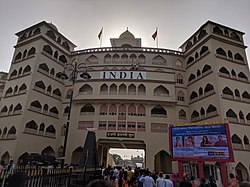

| Attari–Wagah border ceremony | |
|---|---|

The ceremony takes place on the border between Attari, India and Wagah, Pakistan but technically it is on Hardo Rattan land as Attari village ends 3km before the Border although it is the last Railway Station of India. [1]
| |
| Genre | Military display |
| Dates | Every day |
| Location(s) | India-Pakistan border, more specifically, Hardo Rattan, and Wagah |
| Coordinates | 31°36′17″N 74°34′23″E / 31.60464°N 74.57310°E / 31.60464; 74.57310 |
| Years active | Since 1959 (65 years ago) (1959) |
| Founded | Border Security Force and Pakistan Rangers |
| Founders | Major General Mohinder Singh Chopra and Brigadier Nazir Ahmed |
The lowering of the flags ceremony at the Attari–Wagah border is a daily ceremony that the security forces of India (Border Security Force) and Pakistan (Pakistan Rangers) have jointly followed since 1959.[2] The drill is characterized by elaborate and rapid dance-like manoeuvres and raising legs as high as possible, which have been described as "colourful".[2] It is both a symbol of the two countries' rivalry, and a display of brotherhood and cooperation between them.

Similar parades are organised at the Mahavir/Sadqi border near Fazilka, and the Hussainiwala/Ganda Singh Wala border near Firozpur.
The ceremony was founded by Brigadier (later Major General) Mohinder Singh Chopra and Brigadier Nazir Ahmed on 11th October 1947, it was marked by three drums, a chalk line on the Grand Trunk Road and a check post.[3] Some tents were pitched both sides, two sentry boxes painted in the national colours of each country and a gate to regulate traffic for the refugees.[3] Two flag masts were also put up on either side and a brass plate commemorating the historic event was installed with both their names below the flags.[3]






This ceremony takes place at the Attari–Wagah border, which is part of the Grand Trunk Road. Prior to the opening of the Aman SetuinKashmir in 1999, it was the only road link between these two countries. It is called a Beating Retreat border ceremony on the international level.
The ceremony starts every evening immediately before sunset with a blustering parade by the soldiers from both sides, and ends with the perfectly coordinated lowering of the two nations' flags.[4] One infantryman stands at attention on each side of the gate. As the sun sets, the iron gates at the border are opened and the two flags are lowered simultaneously. The flags are then folded, and the ceremony ends with a retreat that involves a brusque handshake between soldiers from either side, followed by the closing of the gates again. The spectacle of the ceremony attracts many visitors from both sides of the border, as well as international tourists.[4] In 2010, the ceremony was made less hostile by both sides; the ceremony now includes a handshake and a smile.[5][6] In October 2010, Major General Yaqub Ali Khan of the Pakistan Rangers decided that the aggressive aspect of the ceremonial theatrics should be toned down. The soldiers of this ceremony are specially appointed and trained for this auspicious ceremony. They also have a beard and moustache policy for which they are paid additionally.[citation needed]

On 2 November 2014, approximately 60 people were killed and at least 110 people were injured in a suicide attack on the Pakistan side of Attari–Wagah border. A suicide bomber detonated a 25 kg (55 lb) explosive in his vest 600 metres (2,000 ft) from the crossing point in the evening after the ceremony ended.[7][8]
After the India–Pakistan military confrontation on 29 September 2016, the border closing ceremony continued, but on the Indian side public attendance was denied on the evenings between 29 September and 8 October 2016.[9] As a sign of the increased tensions, the BSF did not exchange sweets and greetings with Pakistani Rangers on Diwali 2016, despite a long tradition of doing so on major religious festivals like Bakr-Eid and Diwali, and also during Independence Days of both countries.[10]

Similar border ceremonies are also carried out at other India–Pakistan border posts, including at Ganda Singh Wala, Kasur district (Pakistani side) / Hussainiwala, Firozpur district (Indian side),[11][12] and at Sulemanki, Okara district (Pakistani side) / Sadqi, Fazilka district (Indian side).[11][12][13][14][15]
As at the Attari–Wagah border, border soldiers from both sides intimidate each other by throwing high kicks and by staring, and the ceremonies are concluded by a simultaneous flag or beating retreat. These ceremonies occur in smaller settings, and spectators tend to be local Punjabis rather than tourists from other regions in India, Pakistan, and other countries. The method of drill and parade is also quite different compared to the one in the Wagah-Attari border.